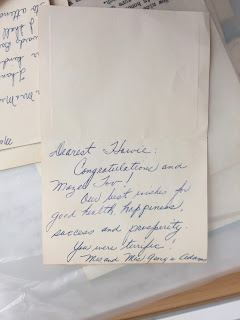People are waiting longer to have kids or not having kids at all, which leads to more dual income households with no kids.
Category Archives: family
Oldest, Youngest, and Middle Children, in Differently Sized U.S. Households
When talking to someone new, the conversation often leads to your family when you were growing up. Do you have siblings? Older than you? Younger? I thought I’d try answering the questions for everyone in the United States. The chart below shows the distribution of kids younger than 18 by birth order and number of kids in the household.
Posted by in Data Underload, family, kids
Change in Common Household Types in the U.S.
In the 1970s, the most common household type in the U.S. was a married couple with kids. But over time, as people wait longer to get married and have fewer kids (if any), it’s grown more common to live alone or with non-family.
Posted by in Data Underload, family, households
What to Call Your Distant Relative
When you have a big family, it's a challenge to figure out how everyone is related. So here are some charts to help you figure it out. Read More
Posted by in Data Underload, family, relatives
Family displacements through urban renewal
Hundreds of thousands of families were displaced in the 1950s under “urban renewal” programs. The families were disproportionately minorities. Renewing Inequality, from a research group at the University of Richmond’s Digital Scholarship Lab, revisits the topic and how it reflects in the present.
Renewing Inequality presents a newly comprehensive vantage point on mid-twentieth-century America: the expanding role of the federal government in the public and private redevelopment of cities and the perpetuation of racial and spatial inequalities. It offers the most comprehensive and unified set of national and local data on the federal Urban Renewal program, a World War II-era urban policy that fundamentally reshaped large and small cities well into the 1970s.
Many of the people displaced never receive promised compensation or fair market value for their property, which is kind of messed up.
Avoid Food Poisoning During Summer Picnics


When I think about summer picnics, I think about family. I think about my cousins, aunts, uncles, kids running around, a pavilion, and an enormous buffet table loaded with delicious food. The quantity of side dishes and desserts is exceeded only by the number of dad jokes we’re forced to endure. Since I’ve been working with foodborne disease, I’ve made a point to share tips with family members who are preparing food so we can avoid getting sick from food poisoning.
Let’s enjoy National Picnic Month by taking a few simple steps:
Keep foods cool
Rates of food poisoning increase in summer months because bacteria grow faster in warmer weather. Eating food left in the Danger Zone (40°F to 140°F) for too long can make people sick.
- Keep raw meat, poultry, and seafood chilled until ready to grill, in the fridge or in an insulated cooler, below 40°F.
- Put leftovers in the freezer or fridge within two hours of cooking –or ONE hour if above 90°F outside.
- Throw away any remaining perishable food that isn’t refrigerated.
Cook meat thoroughly
It’s important to cook food to a safe internal temperature to destroy harmful bacteria. Never partially grill meat and finish cooking it later.
- Use a food thermometer to make sure meat is cooked hot enough to kill germs. You can’t tell just by looking at it! (145°F for beef, pork, fish; 160°F for hamburgers and ground meat; 165°F for chicken or turkey).
- If you’re smoking meat, keep the temperature inside the smoker at 225°F to 300°F.
- Keep cooked meats hot and out of the Danger Zone before serving.
Clean hands and produce
- Wash fresh vegetables and lettuce. If you’re not sure whether water will be available to wash on site, rinse produce before packing for the picnic.
- Wash your hands before handling any food AND after touching raw meat, poultry, or seafood. If soap and water are not available, use an alcohol-based hand sanitizer that contains at least 60% alcohol.
- Clean work surfaces, utensils, and the grill before and after cooking.
- Examine the grill surface carefully for bristles that might have dropped off the grill brush. They could get into your cooked food and hurt you if swallowed.
Separate raw from cooked
You never want bacteria from raw meat or seafood to contaminate other foods, surfaces, or utensils.
- Throw away or thoroughly cook marinades and sauces that have touched raw meat or seafood.
- Put cooked meat on a clean plate.
- Keep raw meats, poultry, and seafood away from cooked and ready-to-eat food and drinks.
- Don’t use the same utensils on raw foods and cooked and ready-to-eat foods.
This summer, I’m going to work hard to try to avoid being one of the 48 million Americans who get food poisoning every year. Let’s raise a glass of iced tea to well-cooked burgers, rinsed veggies, and chilled fruit salad!
Learn more
Posted by in Aunts, Avoid, Cousins, Desserts, family, food, food poisoning, Foodborne, Kids Running Around, National Picnic Month, Picnics, Preparedness, public health, Sick, Side Dishes, summer, Summer Picnics, Uncles
A time capsule from my father’s youth – the secrets of a 62 year old Bar Mitzvah book on his 75th birthday
Sadly, he is no longer alive. He passed away in 1987, when I was a freshman in college. It was a painful ending of his life. I have written about this. As has my brother Michael. As have some other people here and there. If you want to know more about that, well, here are some links to read.
- A day to think, to pause, to ponder. Posted by me February 7, 2013.
- My quest to free my father's publications
- David Dobbs in Wired Free Science, One Paper at a Time
- David Dobbs follow up "Jonathan Eisen frees (almost all) his father's papers."
- My page about this
- Mother Jones article about my brother Michael Eisen with a discussion of our father.
- My brother's post from February 8, 2013: My father, Aaron Swartz, and assigning blame for suicide
- My brother on scientific witchhunts: Yoshiki Sasai and the deadly consequences of science misconduct witchhunts
But fortunately there was other information in the book. Some of it was all the congratulation cards and telegrams he and his family received. See for example these
But it was other details about the Bar Mitzvah itself that ended up being the most interesting and useful to me. For example, my grandmother even kept all the details on planning the food
And also included in the book was information on the ceremony - the order of events and who did what. This was helpful since these actually listed some names of people I knew very little about.
Posted by in ancestry, family, family trees, Howard Eisen, michael eisen, time capsule
June is National Safety Month – Stand up to Falls

 June brings summer to our doorstep, along with National Safety Month. This year’s theme encourages us to “Keep Each Other Safe.” One of the best ways to keep each other safe is to “Stand Up to Falls.”
June brings summer to our doorstep, along with National Safety Month. This year’s theme encourages us to “Keep Each Other Safe.” One of the best ways to keep each other safe is to “Stand Up to Falls.”
Adults 65 and older are the most vulnerable for falls and falls are the number one cause of injuries and injury deaths in this age bracket. As 10,000 Baby Boomers turn 65 each day, more and more of us will have family, friends, and neighbors who age into this high risk pool.
Older adult falls are truly a growing problem. Although many seniors are more active and living longer, more than 1 in 4 report falling. Emergency departments treat over 3 million older Americans for falls each year while direct medical expenses add up to more than $31 billion annually. As falls and fall injuries are increasing, chances have also increased that you know someone who has fallen this past year.
What can you do to Stand Up to Falls?
Fortunately, falls are preventable and we can all take steps to protect the health and wellbeing of older Americans. To assist, the Centers for Disease Control and Prevention (CDC) is committed to helping older Americans age safely and without injury. This means ensuring that older adults and those who care for them have the tools and resources needed to assess their fall risk and information on how to effectively reduce that risk.
CDC encourages all older Americans to:
 Speak Up – Falls can cause severe injury and loss of independence. Therefore it’s important to talk openly with your healthcare provider about falls and your health goals. Healthcare providers are well positioned to screen for fall risk, using evidence-based tools such as those included in the Stopping Elderly Accidents, Deaths & Injuries (STEADI) initiative, assess modifiable fall risk factors (e.g., poor balance, the use of certain medications, vision impairment), and to offer effective strategies to help their patients prevent a fall so that they can meet their health goals.
Speak Up – Falls can cause severe injury and loss of independence. Therefore it’s important to talk openly with your healthcare provider about falls and your health goals. Healthcare providers are well positioned to screen for fall risk, using evidence-based tools such as those included in the Stopping Elderly Accidents, Deaths & Injuries (STEADI) initiative, assess modifiable fall risk factors (e.g., poor balance, the use of certain medications, vision impairment), and to offer effective strategies to help their patients prevent a fall so that they can meet their health goals.
If you are a friend or caregiver of an older person, encourage them to speak up and talk to their doctor if they have fallen, feel unsteady, or worry about falling. They should also ask about vitamin D supplements for improved bone, muscle, and nerve health. CDC has fall prevention resources available for older adults and those who care for them, such as the brochures, Family Caregivers: Protect Your Loved Ones from Falling and Stay Independent: Prevent Falls.
Make Your Home Safe – Most falls happen at home, so it’s important for older adults to check their homes – inside and out – for safety. CDC offers a brochure, Check for Safety that includes a fall prevention checklist. This list contains simple preparedness actions that often get overlooked:
- Get rid of things you could trip over.
- Add grab bars inside and outside of your tub or shower and next to the toilet.
- Put railings on both sides of stairs.
- Make sure your home has lots of light by adding more or brighter light bulbs.
Keep Moving – Older adults can reduce their risk of falling by improving their balance and strengthen their legs. CDC encourages older adults to keep moving and stay active with evidence-based activities like Tai Chi. Exercise and movement can also make you feel better and more confident. Check with your healthcare provider about the best type of exercise program for you or your loved one.
Falls affect us all—whether personally or someone we love or care about. Encourage older adults you know to take steps toward living longer and healthier lives. Let’s continue to keep each other safe during National Safety Month and stand up to falls!
Resources
Posted by in Baby Boomers, death, Fall injuries, Falls, family, Friends, General, High Risk, injuries, injury, Keep Moving, Make Your Home Safe, National Safety Month, Neighbors, Older adult falls, PHPR: Health Security in Action, Preparedness, public health, Response, Seniors, Speak Up, Stand Up to Falls
Protect Your Child this Flu Season: Get a Flu Shot!

As fall approaches, cold weather isn’t the only thing you and your family need to prepare for. Flu season is on its way, and it will be here before you know it. Now is the time to make sure that you and your family are protected from flu by getting your flu vaccine by the end of October, if possible.
The Best Way to Protect Your Family
Even healthy children can get the flu. Did you know that children, especially school-aged children or children in day care, are more likely to get sick from flu? Your child is likely to be exposed to flu in a classroom or daycare setting, and millions of children get sick with flu every season. It’s important to make sure that your child is protected this flu season, and the first and most important step in protecting you and your family from flu is by getting everyone an annual flu vaccine.
Nasal Spray Flu Vaccine is Not Recommended This Season
 Flu shots can sometimes be difficult, scary, and uncomfortable for kids (and parents). For several years, some parents have opted to get their children the nasal spray flu vaccine, commonly known as FluMist®, to avoid another shot for their kids. Doctors and scientists also appreciated having the nasal spray flu vaccine as an option that might help encourage needle-averse people to get vaccinated. Studies done soon after the nasal spray flu vaccine was approved showed it was performing as well as (and sometimes better than) flu shots.
Flu shots can sometimes be difficult, scary, and uncomfortable for kids (and parents). For several years, some parents have opted to get their children the nasal spray flu vaccine, commonly known as FluMist®, to avoid another shot for their kids. Doctors and scientists also appreciated having the nasal spray flu vaccine as an option that might help encourage needle-averse people to get vaccinated. Studies done soon after the nasal spray flu vaccine was approved showed it was performing as well as (and sometimes better than) flu shots.
Unfortunately, recently there have been problems with how well that vaccine has worked. The reason for this is not known, but experts are looking into the situation with the hopes that nasal spray flu vaccine might again be an option for kids and parents. In the meantime, CDC and the American Academy of Pediatrics (AAP) recommend flu shots this flu season, not the nasal spray flu vaccine. Flu shots work and can keep your child from getting sick!
As you are planning to get your family vaccinated this fall, remember that some children 6 months through 8 years of age require two doses of flu vaccine. If your child is 6 months through 8 years and is getting vaccinated for the first time, or has only previously gotten one dose of vaccine, then they should get two doses of vaccine this season. The two doses need to be given at least four weeks apart. For children who will need two doses of flu vaccine, the first dose should be given as early in the season as possible to allow time for the second vaccine to kick in before flu starts to spread in your community.
For other children, it is good practice to get them vaccinated by the end of October; however, getting vaccinated later can still be protective as long as flu viruses are circulating. Ask your child’s doctor or other health care professional if your child needs two doses of flu vaccine.
Visit Children, the Flu, and the Flu Vaccine for more flu and flu vaccine information specific to children.
Flu Can Be Dangerous for Some Children
The flu may be more serious than the common cold for children. Flu symptoms can be severe and flu illness can lead to serious complications that require hospitalization.
Some children are at especially high risk of serious flu-related complications:
- Children younger than 6 months old are too young to be vaccinated. The best way to protect them is to make sure you and others around them are vaccinated.
- Children aged 6 months up to their 5th birthday, even those that are healthy, are at risk simply because of their age.
- In some studies, American Indians and Alaskan Natives are more likely to have severe flu illness that may result in hospitalization or death.
- Children aged 6 months through 18 years with certain chronic health problems, such as asthma, diabetes, or neurological and neurodevelopmental conditions.
It’s important to make sure young children and children with certain chronic health problems are vaccinated against flu, as well as any family members and caregivers in contact with your family.
Vaccinate the Whole Family
CDC recommends that everyone 6 months of age and older get a seasonal flu vaccine. You and your family should be vaccinated every year for the best protection against flu. Many children get sick from flu every flu season, and some of those illnesses result in death. Every year in the United States, an average of 20,000 children younger than 5 years old are hospitalized due to flu complications. Flu vaccination can reduce flu illness, doctors’ visits, and missed work and school due to flu, as well as prevent flu-related hospitalizations for you and your family.
Flu vaccines are offered in many locations, including doctor’s offices, clinics, health departments, pharmacies, and college health centers, by many employers, and even some schools. You may not have to see your doctor to get your child a flu shot! There are plenty of locations available that provide vaccinations. The Vaccine Locator is a useful tool for finding areas in your community offering flu vaccine.
More information for parents is available at: http://www.cdc.gov/flu/parents/index.htm.
Posted by in children, family, flu, Prevention/Vaccination, Vaccination























































































